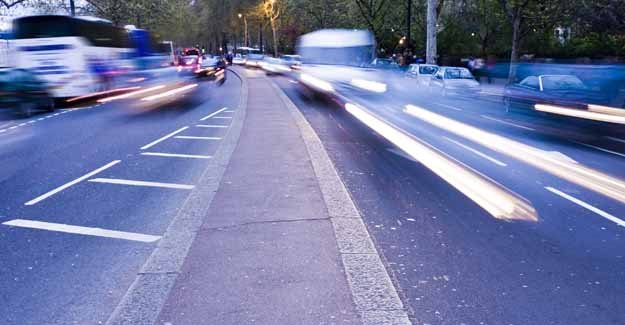Up to 70% of the signs on our rural roads are unnecessary and could be removed, according to Paul Miner, CPRE’s [1] planning campaigner, speaking today at the IHIE Conference in Loughborough. [2]
Paul Miner will unveil the initial findings of an audit of the A32 in rural Hampshire. [3] CPRE and the RAC Foundation [4] have joined forces to call for all highway authorities across England to begin a programme of similar ‘clutter audits’. We are keen to work with authorities in carrying these out.
Delegates at the conference will be shown the value of alternatives to traditional road signs and markings to address the problem of speeding in the countryside. For example, the use of ‘shared space’ at Shipbourne, within the Kent Downs Area of Outstanding Natural Beauty, could potentially save up to 125 additional signs in addition to a whole range of standardised road markings. [5]
CPRE is urging the Government to follow the example of the Scottish Government and issue detailed policy guidance for Highway Authorities and engineers on how to address landscape issues in the designing of their roads and the fixing of signage. [6]
Government policy should also require highway authorities to address clutter in the next round of Local Transport Plans in 2010. Creating a more distinctive environment can enhance the beauty of the countryside and encourage motorists to react more to their surroundings, driving more carefully and slowly as a result. [7]
Paul Miner will say:
‘The Government wants local authorities to be “place-shapers”. The best place everyone can start is by looking at the appearance of our roads. Most of our rural roads are a mess of unnecessary and standardised signage that looks bland and encourages irresponsible motoring.
‘By getting rid of this clutter, local councils, highway engineers and communities can make our countryside a safer and more attractive place to be. CPRE and the RAC Foundation are ready to help them take on the challenge.’
Sheila Rainger, Head of Campaigns at the RAC Foundation, said:
‘Road signs are designed to warn, instruct and advise, but if overused they simply confuse. Highways Authorities have the best of intentions, hoping that additional signs will enhance road safety, but a surfeit of signs can lead to disaster. Their physical presence on the roadside threatens bikers and cyclists, while the mental load required to process excess information compromises drivers’ concentration. Over 150 local authorities in Germany have purged their verges of excess signs and we urge UK councils to follow suit.’
– END –
NOTES FOR EDITORS
1. CPRE, the Campaign to Protect Rural England, is a charity which promotes the beauty, tranquillity and diversity of rural England. We advocate positive solutions for the long-term future of the countryside. Founded in 1926, we have 60,000 supporters and a branch in every county. President: Bill Bryson. Patron: Her Majesty The Queen.
2. The conference, Traffic Signs 2007: Getting it Right!, is being held on Thursday 20 September, 2007, at the James France Exhibition Area, Central Park, Loughborough University. It has been organised by the Institute for Highway Incorporated Engineers (IHIE). Paul Miner will be speaking on ‘More Character, Less Clutter’. He will be available for interview. The 70% figure quoted is intended to refer to secondary A roads, B roads and lesser roads rather than motorways or primary and trunk A roads, though in many cases there is also scope to reduce the numbers of signs on these roads as well.
3. The audit of clutter took place on the A32, a secondary A road, between West Meon and Wickham in Hampshire during summer 2007. The 70% figure is based on information provided by Hamilton-Baillie Associates (web: www.hamilton-baillie.co.uk), who acted as consultants to Hampshire County Council. CPRE Hampshire campaigned for the project to take place and has been involved in the project since its inception in 2005.
4. The RAC Foundation for Motoring is an independent charity established to promote the environmental, economic, mobility and safety issues relating to use of motor vehicles.
5. This refers to the results of an initial feasibility study carried out by Hamilton-Baillie Associates at Shipbourne, within the Kent Downs Area of Outstanding Natural Beauty. CPRE branches and groups across England are also working on the issue of clutter. For more details contact CPRE’s press office on 020 7981 2880.
6. Transport Scotland’s guidance notes Road Furniture in the Countryside is available from www.transportscotland.gov.uk/uploads/documents/j7538.pdf or by telephone on 0131 622 8283. Page 42 of the guidance calls on highway engineers to fix supporting poles on road signs correctly, to ensure that they do not protrude above the top of the sign and cause unnecessary visual impact in the countryside. CPRE has been informed of a number of cases in Suffolk where poles have not been fixed correctly to signs on major roads. The pictures are available from CPRE’s press office.
7. See, for example, the work of Hans Monderman in the Netherlands, and David Engwicht (www.mentalspeedbumps.com). The best known example of Monderman’s work is the town of Drachten, where over half the road signs were removed. According to Spiegel magazine (16 November 2006), there has been no detrimental effect on road safety (www.spiegel.de/international/spiegel/0,1518,448747,00.html).


